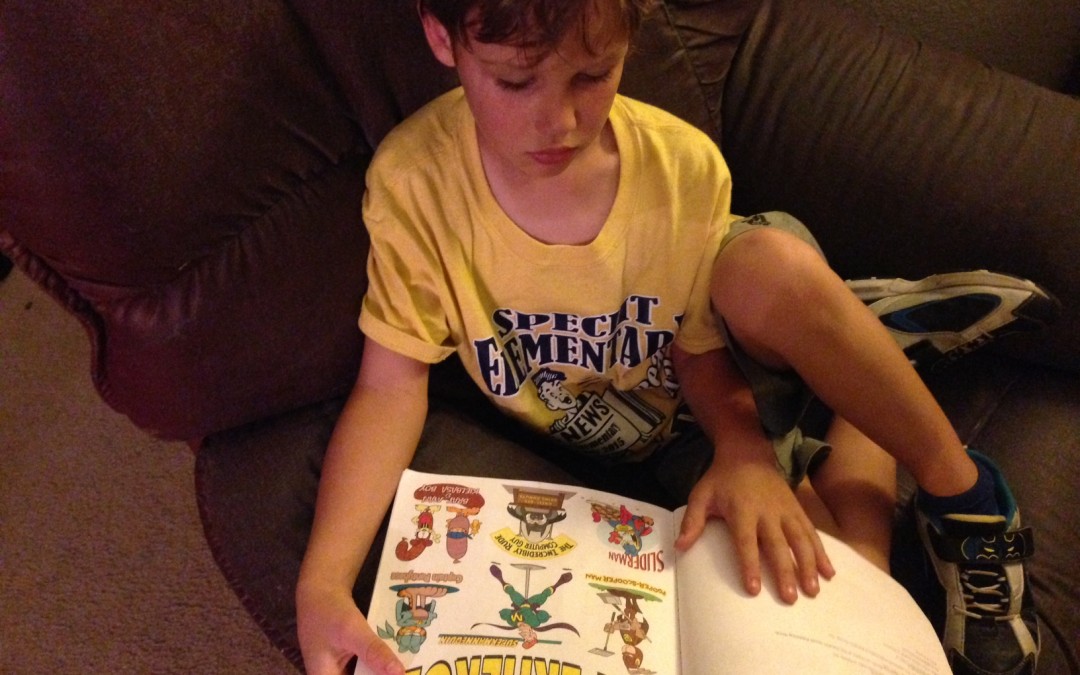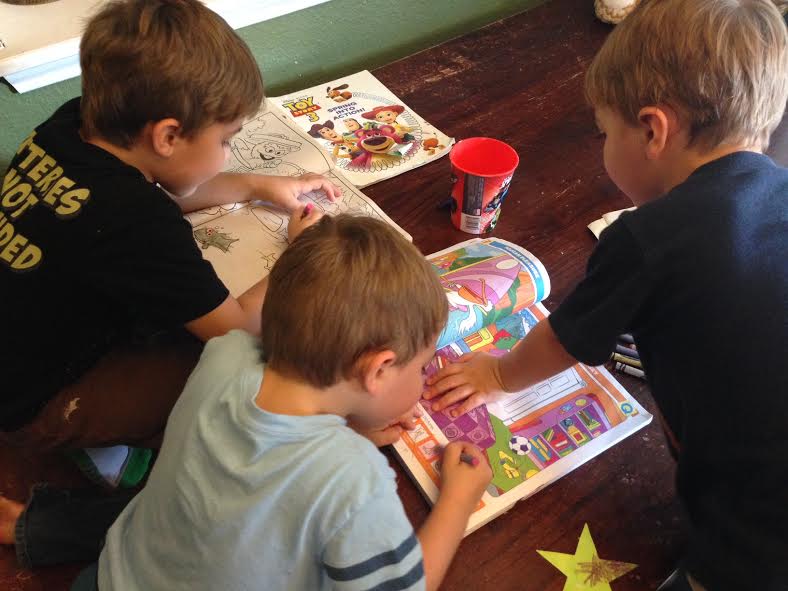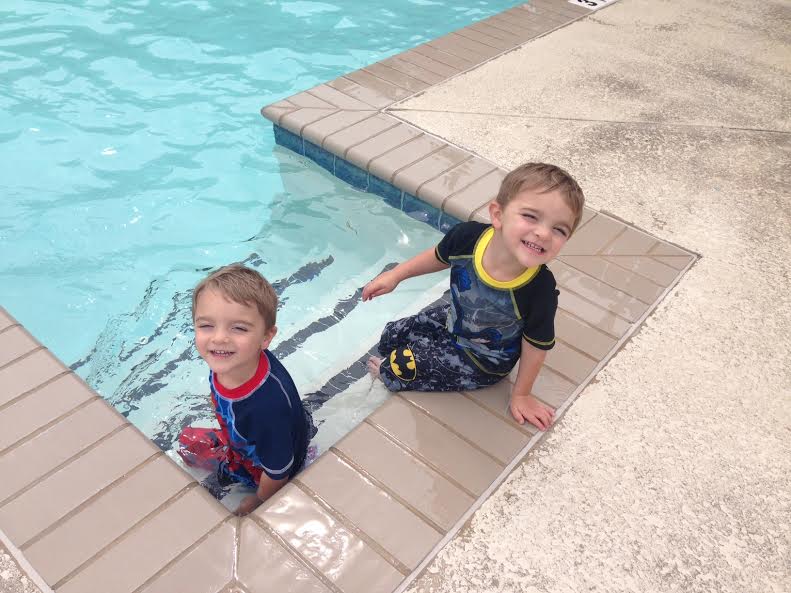
by Rachel Toalson | My Good Journey
We are settling into earlier mornings and sleepier breakfasts and homework instead of free play in the after school hours. We are settling into shorter bedtime windows and showers in the morning rather than at night and schedules that line up with when they need to be at school and when they can come back home.
Though it means 5 o’clock mornings, I always look forward to the month after school starts, because it means we have begun to stretch into those familiar routines that we left behind all summer.
I enjoy those summer days that are not bound by places we need to be or a clock that rules us or tasks we need to finish before the deadline, but there is something about getting back into a routine of carefully measured activity that feels refreshing.
Routine is life-giving to me.
I used to think this made me boring. I wanted to be the fun, spontaneous type who could make plans or drop them with no more notice than a call. I tried to be her for a while, but I was miserable.
That could be why, when we had children, I slipped so easily into routine. Feed the baby, let him play, put him to sleep, do it all again. Feed the toddler, read to the toddler, put the toddler down to sleep, repeat. Feed, play, feed, play, feed, bathe, read, snuggle, sleep.
My life runs like one great routine. My boys know exactly what’s coming and where they are in their days because of the routines we have practiced since the day they were born. They could do it with their eyes closed.
It’s no secret that I have a large family. Six children is four more than what most people consider the norm. Which means we often get interesting questions about our large family—but the most frequent one I hear is, “How do you do it?”
Usually, when people ask this question, I tell the truth: I don’t do it. I don’t even come close. My house hasn’t been cleaned in you don’t want to know how long. The laundry is still sitting on the banister like it was three weeks ago, so the kids have gotten used to living out of a pile instead of a closet. The yard has more weeds than grass because there’s just no time to tend.
But another truth is routine.
Routine helps me do it. Every Monday morning I water the plants. Every Tuesday I do laundry. Every Wednesday I shop for groceries (and hope they’ll last all week).
Routine helps my children do it, too.
Something I’ve learned in my eight years of parenting is that routine has a way of settling children. It has a way of making them feel more secure in their constantly changing lives. It has a way of communicating love and intention and joy.
Routine has a power that pulls families closer together.
What I remember most from my childhood are the every-evening stories my mom read to us. I remember getting dressed every morning for school and inevitably opening my closet to find my sister asleep on the floor, still in her pajamas. I remember riding bikes and roller skating the bumpy road out in front of our house while my mom whizzed past on skates of her own.
What my boys will remember in the years to come is not how crazy this household was or how often a brother made them angry or how much food they swiped from the fridge when we weren’t looking. They will remember the routines. The chapter books we read together during our read-aloud time. The flower we stood in the middle of the table and told everyone to sketch, and how each of those drawings came out looking completely different. The snuggle time just before lights out.
Routines offer us stability and structure and sanity.
Mostly they offer us love-filled memories.
How we can incorporate routines into our daily lives
1. Establish a time when everyone sits down at the table together for at least one meal a day. This doesn’t have to be dinner. It could be breakfast or lunch or dunch (a cross between dinner and lunch—which might work for older kids who have crazy evening practices and games). It doesn’t matter what time. Just sit down at the table together and open conversations or play dinner games or name your gratitudes. The family that eats together stays together.
2. Before you leave the house, breathe. We do this with our children in the mornings. Before walking to the school down the road, we stop at the door, take three deep breaths and then get on our way. Sometimes we say a mantra, like “I breathe in love. I release love into the world.” Sometimes we just breathe silently because it’s been a rough morning. This routine helps us slow down and think and claim just one calm moment out of the many rushed ones.
3. Read a story together. Kids love the routine of reading together. People ask me all the time when I think my boys will stop enjoying this time. The answer is never. Mostly because we read long, involved chapter books that take months to finish. I don’t think kids every outgrow stories read by their parents.

by Rachel Toalson | My Good Journey
I’ve just finished reading him the project we decided on this summer—a picture book they’ve all written and will illustrate—when he looks at me and grins.
“Are we going to sell it, Mama?” he says, because he’s 8, and he’s always looking for ways to make money, this little entrepreneur.
“Of course we are,” I say. “But we still have to do a lot of work from here.”
“Okay,” he says.
And he gets back to work, poring through all those picture books to see how many pages are in them and how many pages his book will need to have and how we’ll break up all that text to match with pictures.
It all came about after a school’s-out dreaming session, which we do every summer, to talk about what we will do with our summer and what project we’ll create in the free days we have.
All three of our older boys chose to write books (which made their mama so happy).
I knew it was a lot of work, because I do this on a daily basis, and so we sat down to have a dreaming session, talking about what our projects would look like and how they would be completed and how much time we would need from start to finish.
We planned how to put feet on our dreams—feet that will run and jump and play and accomplish what is in our hearts to do.
We do this often with our children.
The practice began back when we chose our family values and added “We unveil dreams” as an important one. We had our first dream session where we dreamed about what we wanted to be when we grew up (parents included). And then made a plan of pursuit.
We conduct Dream Sessions with our kids periodically during the year, to evaluate whether our dreams have changed and whether we’re still on a path of pursuit or we’ve gotten a little sidetracked. We share our dreams with our children, and they share their dreams with us. We dream family dreams.
Dreams are important to our children. Dreaming together is important for our children. The time we take to engage with them this way shows them that we believe in them, that we believe they can become what they dream they’ll become, with enough hard work and effort. Dream Sessions show our children that they have the potential to change the world. They communicate our knowledge and our expertise and, most importantly, our belief that they have it in them.
The first dream session we had, our oldest, who was 5 at the time, said he wanted to be a cinematographer. Since that dream has not changed all these years later (he’s 8 now), he continues to study videography. He reads biographies about people like George Lucas and Walt Disney to learn how to animate. He reads every comic book he can get his hands on, because he knows that a foundation in story and pictures is what it takes to be a successful videographer. He studied a screenwriting book to learn the techniques necessary for writing a good screenplay.
It’s not unusual that I will find original comic books he’s written and left on his desk or my bed or the kitchen table, because he set down a dream and he is working toward it.
Our kids are natural dreamers. They don’t know the limits of possibility and impossibility. We can learn how to dream by watching our children.
We don’t tell them what’s possible and what’s not, because we don’t ever know, either. Just because it wasn’t possible in our life doesn’t mean it’s not in theirs. Because something else dreaming does is it teaches kids that dreaming takes hard, intentional work. Anyone who puts in the work can achieve a dream, but the work must be put in.
Jesus dreamed of a church that would meet needs and take care of the people and love them for who they were and wherever they were in their faith. So he did the work, keeping his disciples close, teaching them, helping them see the work they would have to do when he was gone.
Jesus was a dreamer. He was a teacher.
I want to be like him.
How to hold a Dreaming Session with young children:
1. Get the crafts out. Have them draw pictures of what they want to be when they grow up. Sometimes kids need a little help with this one, but if they say “Batman,” which is what my 3-year-old wants to be when he grows up, see it for the spirit behind it. He wants to keep the city safe from bad guys. Help him learn how to do that.
2. Start a dream folder for your child. Put snippets of newspaper or magazine clippings or a list of links and resources to help them learn more about their dream. If you know how to do what they dream about doing, share your expertise.
3. Periodically evaluate with your children what they’re doing to achieve their dreams. Dreams aren’t worth much without a plan. Help your children make plans and constantly adjust plans as their dreams change. We hold Dream Sessions once a quarter.

by Rachel Toalson | My Good Journey
It’s been a rainy summer, which means kids have been cooped up inside the house (because mud. And boys.), and everyone is touching me, and what I would give, what I would give for some cable television to distract them.
We got rid of cable years ago, back when the oldest was 3 and we decided we didn’t really want to afford the expense because it really wasn’t worth it.
Fast forward five years and four additional kids, and now here we are, nearing the end of the kids’ summer break, and my boys are fighting constantly, and so much work needed doing but didn’t get done because it’s summertime, and so many days, honestly, I just want to sit them down in front of the television and turn on a movie just to get an hour and a half of peace and quiet, bought with a single flick of the Apple remote.
A mom can only take so much, after all.
Except I know our values, and television, the passive participation in family life, isn’t one of them. Drawing or writing stories or reading books or building amazing contraptions from blocks or painting masterpieces or running wild outside—those all fit in with our values, but they’re so much harder.
So much harder on the days I’m already exhausted.
But the truth is, I want my boys to engage their minds and bodies in ways that can’t be done in front of a screen, even if we’re “sharing” the screen time together by watching a movie.
It’s not really shared time for me, because even if I sit down on the couch with them, I know what I’ll do. I’ll engage in other work. I’ll find something else to do besides staring at a screen. I’ll write or read or brainstorm or stare at the baby or think about how I should be washing the dishes.
So it’s not shared activity like building a LEGO tower or coloring a page out of a Spider-Man coloring book or painting an interpretation of The Starry Night.
I grew up with a television and the lure of a screen, but it is nothing compared to the temptation my children face every day in the way of screens.
Our generation of parents is growing up with screens everywhere–iPhones and iPads and iMacs and Apple TV and Internet and social media. So many opportunities for kids to get lost in screens.
These screens can hijack family life in relentless ways.
Especially for parents. People need to get in touch with us, so we keep our phones on and our email (on the phone) open and our social media channels (on the phone) perpetually logged in, just in case.
We are connected all the time.
Sometimes I get tired of this connectivity. Because it’s not real. Because it’s across a screen. Because I know what it can do to real connectivity.
Back when we were deciding our family values, we talked extensively about how it’s so difficult to listen earnestly to our children when we are constantly connected to our screens.
We miss the important things—the way their eyes shine when they read the last page of that chapter book—the first one they’ve read on their own. We miss the funny little dance he did on his way to the potty, the one we might have remembered to show him years later, if we’d seen it.
We miss life.
The first step to walking in greater connectivity with our children is disconnecting in the ways that will foster more authentic connection—and being an example for them.
So that’s what I choose to do, from here on out. I’ll put down my phone. I’ll log out of all those accounts that seem so important and urgent. I’ll keep the television hidden so its “easy” promise won’t start calling.
I’ll look at them and be with them and engage fully in their minutes and hours and days.
The life unfolding before my eyes is worth seeing.
Ways to connect besides screens:
1. Read an audio book together. This is such a special, shared experience for a parent and child. There are some amazing audio books at local libraries that rival theatrical productions. My boys will sit, riveted, for hours when we find a good one (and we recheck it as often as we can—because moms need a break, after all!). Some of our favorites: Peter Pan, read by Jim Dale. Hatchet, read by Peter Coyote. There’s a Boy in the Girl’s Bathroom, read by Lionel Wilson. The Harry Potter series, read by Jim Dale.
2. Write a picture book together. We are doing this with the 8-year-old, 6-year-old and 5-year-old the real way—publishing it on Amazon and everything. But, on a much smaller scale: Get 18 sheets of computer paper and fold them in half. Help your child write a story on the pages and then let him/her draw all the pictures that go inside.
3. Have a dance party. Turn the tunes up high and get down. This promises plenty of giggles and fun. Kids love to dance, and it’s good for their bodies to get moving. My boys love to dance, and there’s nothing more effective for cutting tension in two (at least not in our house) than breaking into a silly dance.

by Rachel Toalson | My Good Journey
A few days ago, we packed up in our minivan, every seat in this eight-capacity vehicle occupied, and went to Family Camp.
Family Camp is a place we have been four years running—a retreat over a three-day weekend where families can take time to reconnect, play together and rest.
We usually are the youngest family there.
It took me a while to figure this out. The camp, with its canoe capabilities and its swimming pool with a slide and its large wooden playground, seemed like it would appeal to parents of kids as young as ours.
And then I remembered the packing and the traveling and all of the logistics must be worked out to successfully road-trip with young children.
It’s exhausting.
The day we left, we had plans to leave right after the baby ate, which was usually around 3 p.m. It was only a 2.5-hour drive, so we should have been able to make it before the baby needed to eat again.
Except my husband didn’t start packing the car until I sat down to feed the baby, and it took a whole hour to fit everything inside the crammed-full car.
Except two minutes down the road one of the bigger boys said he needed to go potty, and we knew he wasn’t joking, and then everyone else, of course, said they needed to go, too, because it meant a break from the car (already).
Except we ran into torrential rain and heavy traffic.
A 2.5-hour road trip turned into a six-hour drive.
By the end of it, our kids were whining, the baby was screaming and I said we would never, ever do this again, because it was just.too.hard.
And it’s true. It was hard. Even the retreat was hard, because 3-year-old twins don’t make anything easy.
But the time spent away was good for us. It was good for our family. The 8-year-old learned how to row a canoe with his daddy. The 6-year-old strung beads and blessed all the mothers at the retreat with a pretty nametag necklace. The 4-year-old found a Batman mask in the treasure box set out the first day and wore it for the entire weekend. The twins painted pictures they never would have painted at home because it was so messy and turned their faces black.
But it was camp, and it was fun, and it was so good to take a weekend to just enjoy each other.
Sometimes the hardest parts are the parts that turn out to be the most life-changing parts.
When we are the parents of young children, it can feel almost impossible to go anywhere, because there is so much to pack and so many unknowns, and the kids will be in the car for so long, and we’ll probably go crazy, and what about the routine?
But sometimes it’s good for us to throw out that routine and accept the unexpected and go a little crazy, because there is little-boy pride in rowing across an entire pond, and there is little-boy excitement at having mastered that humongous twisty slide into water, alone, and there is little-boy joy in having made something beautiful for other people.
Sure, it took an hour to fit all those suitcases around legs and seats and a baby swing. Sure, that trip didn’t turn out exactly the way we planned. Sure, the kids drove us crazy asking every other minute how much longer it would be, but as soon as our car pulled into camp and they read the front sign, they started shaking the back end of the car they were so excited.
It was that minute I felt glad we had braved a road trip with six kids.
To make traveling with young kids a little easier, try this:
1. Bring along some audio books. We checked out some classics: How to Eat Fried Worms, There’s a Boy in the Girls’ Bathroom, Peter Pan, and listened to them during the trip (Tip: Always bring more than you think you need, in case of torrential rains and heavy traffic). Our boys love listening to stories when we’re traveling, and the parents get to listen, too.
2. Give them a small travel kit that’s only used during trips. When we made the 26-hour trip to Florida to visit family, we got each of the boys a new composition book and a small container of crayons and set them free. The 3-year-olds drew one line on every page. The 6-year-old drew works of art and colored them in. The 8-year-old took notes about each state we passed through and called it his Travel Diary. It still sits in his closet, with the date and time we drove up to his grandpa’s house. It’s a great memory for him.
3. Play car games. We all know the typical ones: I Spy or Shapes in the Clouds or Road Trip Bingo. For variety try this one:
Word Association Game: One person picks a word, another says the first word that comes to mind based on the first person’s word. (Example: Person 1 says “Banana.” Person 2 says “Yellow.” Person 3 says “Taxi.”) This can get hilarious with young ones.





